

Survivre et vivre. Un article de Wikipédia, l'encyclopédie libre.
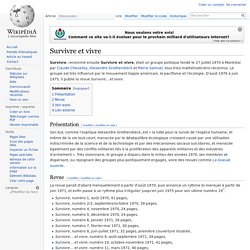
Survivre, renommé ensuite Survivre et vivre, était un groupe politique fondé le 27 juillet 1970 à Montréal par Claude Chevalley, Alexandre Grothendieck et Pierre Samuel, tous trois mathématiciens reconnus. Le groupe est très influencé par le mouvement hippie américain, le pacifisme et l'écologie. D'août 1970 à juin 1975, il publie la revue Survivre... et vivre. Présentation[modifier | modifier le code] Studies/theories about creativity. Innovation 101. Our highly interactive courses feature hours of personalized practice and coaching, with individual and group exercises, group simulation, excursions and practice interviews.
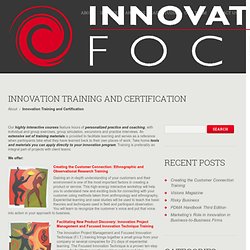
An extensive set of training materials is provided to facilitate learning and serves as a reference when participants take what they have learned back to their own places of work. Take home tools and materials you can apply directly to your innovation program. Training is preferably an integral part of projects with client teams. We offer: Creating the Customer Connection: Ethnographic and Observational Research Training. Guide de l'innovation. Tactical Path of Industrial Innovation. The six types of innovation. Four Types of Innovation and the Strategic Choices Each One Represents.
If you’re like me, you want your brainstorming sessions and new product development projects to be productive and you want the ideas you (and your team) come up with to be relevant to your business’ overall goals.
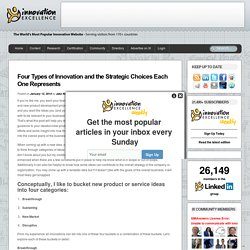
That’s what this post will help you with – giving a guidance to your ideation/new product development efforts and some insight into how those ideas might fit into the overall plans of the business for the future. When coming up with a new idea, often it can be helpful to think through categories of ideas first. For example, I don’t know about you but my creativity is actually enhanced when there are a few constraints put in place to help me know what is in scope or out of scope.
Additionally it can also be helpful to know how some ideas can contribute to the overall strategy of the company or organization. You may come up with a fantastic idea but if it doesn’t jibe with the goals of the overall business, it will most likely get scrapped. Breakthrough Sustaining New Market. A Framework for Strategic Innovation.
Minimum viable product. In product development, the minimum viable product (MVP) is a strategy used for fast and quantitative market testing of a product or product feature.
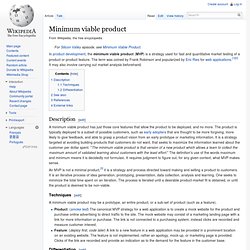
The term was coined by Frank Robinson and popularized by Eric Ries for web applications.[1][2] It may also involve carrying out market analysis beforehand. Description[edit] A minimum viable product has just those core features that allow the product to be deployed, and no more. The product is typically deployed to a subset of possible customers, such as early adopters that are thought to be more forgiving, more likely to give feedback, and able to grasp a product vision from an early prototype or marketing information. It is a strategy targeted at avoiding building products that customers do not want, that seeks to maximize the information learned about the customer per dollar spent.
An MVP is not a minimal product,[3] it is a strategy and process directed toward making and selling a product to customers. Techniques[edit] Cycle of Diffusion of innovations - Everett M. Rogers Model. Everett M.
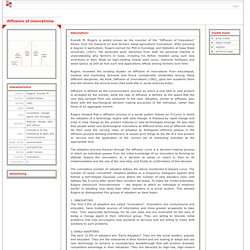
Rogers is widely known as the inventor of the “Diffusion of Innovation” theory from his research on how farmers adopt agricultural innovations. After pursuing a degree in agriculture, Rogers earned his PhD in Sociology and Statistics at Iowa State University (1957). His doctorate work stemmed from both his personal interest in understanding why farmers in Iowa, including his father, resisted using such new inventions in their fields as high-yielding hybrid seed corns, chemical fertilizers and weed sprays as well as how such new applications diffuse among farmers over time.
Rogers reviewed the existing studies on diffusion of innovations from educational, medical and marketing domains and found considerable similarities among these different disciplines. His book, Diffusion of Innovations (1962), gave him academic fame and still remains the second most cited book title in social sciences today. Entonnoir de l'innovation et échelle de Klirton (ppt download SensInno)
3 types d'innovation. 4 facteurs clés de succès d’une innovation disruptive. The golden opportunity of paradigm shifts. These 6 major paradigm shifts, disruptions in how we see the world and do business, present both danger, and opportunity to innovation leadership today.

Open, User and Cumulative Innovation. User innovation. User innovation refers to innovation by intermediate users (e.g. user firms) or consumer users (individual end-users or user communities), rather than by suppliers (producers or manufacturers).[1] Eric von Hippel [2] and others observed that many products and services are actually developed or at least refined, by users, at the site of implementation and use.
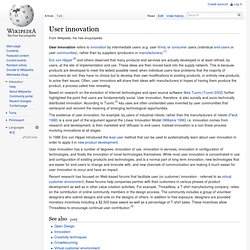
These ideas are then moved back into the supply network. This is because products are developed to meet the widest possible need; when individual users face problems that the majority of consumers do not, they have no choice but to develop their own modifications to existing products, or entirely new products, to solve their issues. Often, user innovators will share their ideas with manufacturers in hopes of having them produce the product, a process called free revealing. The Difference Between Sustaining Innovation and Disruptive Innovation. Innoveracy: Misunderstanding Innovation. Illiteracy is the inability to read and write.
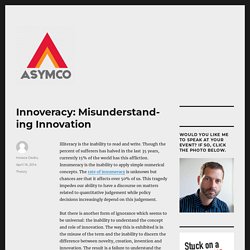
Though the percent of sufferers has halved in the last 35 years, currently 15% of the world has this affliction. Innumeracy is the inability to apply simple numerical concepts. The rate of innumeracy is unknown but chances are that it affects over 50% of us. This tragedy impedes our ability to have a discourse on matters related to quantitative judgement while policy decisions increasingly depend on this judgement. But there is another form of ignorance which seems to be universal: the inability to understand the concept and role of innovation. My contribution to solving this problem is to coin a word: I define innoveracy as the inability to understand creativity and the role it plays in society.
One example is in the following quote: “Lastly, nationally circulating tabloid Ilta-Sanomat gets a look at Nokia’s fabled tablet computer that was developed nine years before the iPad hit the market. Note that the taxonomy has a hierarchy. Innovation — Lies, Promises, and PowerPoints. Benjamin Spiegel | September 8, 2014 | 0 Comments inShare6.

Etat des lieux de la creativite. What is creativity ? How Creativity in Humor, Art, and Science Works: Arthur Koestler’s Theory of Bisociation. By Maria Popova “The discoveries of yesterday are the truisms of tomorrow, because we can add to our knowledge but cannot subtract from it.”
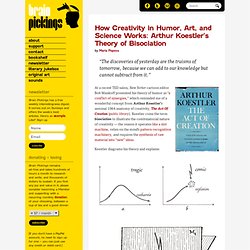
At a recent TED salon, New Yorker cartoon editor Bob Mankoff presented his theory of humor as “a conflict of synergies,” which reminded me of a wonderful concept from Arthur Koestler’s seminal 1964 anatomy of creativity, The Act Of Creation (public library). Koestler coins the term bisociation to illustrate the combinatorial nature of creativity — the reason it operates like a slot machine, relies on the mind’s pattern-recognition machinery, and requires the synthesis of raw material into “new” ideas.
Koestler diagrams his theory and explains: The pattern underlying [the creative act] is the perceiving of a situation or idea, L, in two self-consistent but habitually incompatible frames of reference, M1 and M2. Koestler goes on to discuss the forms this creative instability takes in humor, art, science. Le Processus Créatif - rapport. What Is Creative Intelligence? Wednesday, February 3rd, 2010 1. What is Creative Intelligence? By definition, the creative is unconventional, anarchic, flexible, open and difficult to pin down.
Etudes - Vive l’intelligence créative. Publié le 02 avril 2014 Les études ne sont pas seulement des outils d’aide à la décision mais des stimulateurs de créativité pertinente. Mais pourquoi et comment favoriser l’intelligence créative ? Selon Paul Willis, les hommes ne cherchent pas seulement à survivre économiquement et matériellement mais aussi à donner un sens à leur existence. La matière sur laquelle on travaille étant symbolique et vivante, elle demande une démarche qui soit en affinité avec elle. D’où l’importance : − d’étudier tout ce qu’il y a de « sensible » dans la vie humaine. . − de sortir de la dichotomie entre empirie et théorie pour créer des liens entre les concepts et le désordre du quotidien, et ce grâce à l’imagination.